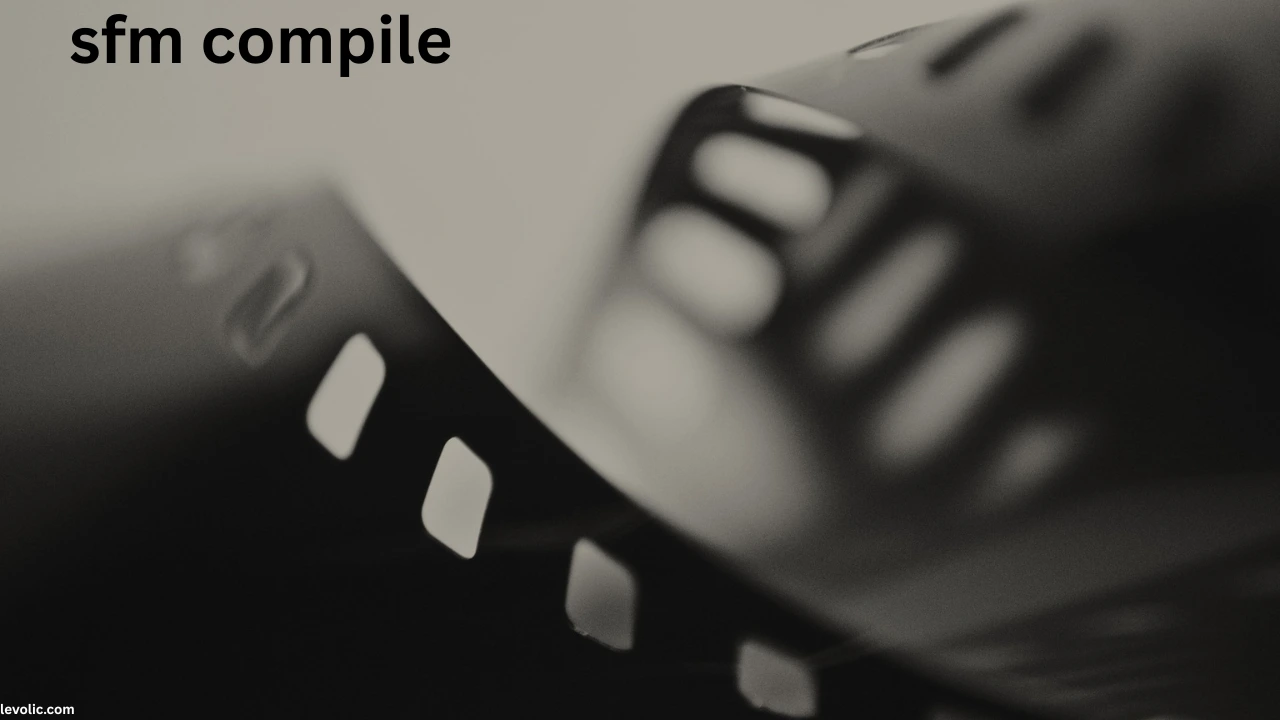SFM Compile Not Working? Fix Common Errors Easily
Creating cinematic animations with Source Filmmaker (SFM) is an exciting journey for content creators, animators, and fans of Valve’s game engine. But one essential process makes all your hard work visible to the world: SFM compile. This critical step transforms your creative timeline into a video or image format, ready for sharing. Whether you’re producing gameplay cinematics, fan trailers, or meme animations, compiling your project correctly is the final yet most important phase.
In this comprehensive guide, we will explain what SFM compile means, how to do it effectively, the technical steps involved, common errors, tips to improve speed and quality, and answers to frequently asked questions. Let’s explore everything you need to know.
What Does SFM Compile Mean?

The term SFM compile refers to the process of exporting your animated project in Source Filmmaker into a usable format. This could be a video file (like AVI), a set of images (image sequence), or a single high-quality screenshot (poster). It is equivalent to rendering in other video software.
Without compiling, your animation exists only in the editor. You can play it in the timeline, adjust effects, and preview motions—but it’s not sharable or final until you export it through the compile feature.
You May Like: nippybox
Why SFM Compile Is Essential
The SFM compile process is what turns your raw animation into a finished product. It adds final touches such as lighting, motion blur, shadows, and camera effects. More importantly, compiling lets you:
- Share your work online
- Upload to YouTube or social media
- Edit in external video software
- Use in portfolios or school projects
Skipping this step means your project remains incomplete, no matter how perfect it looks inside the SFM timeline.
Different Methods of SFM Compile
Source Filmmaker provides three major export options during the compile process. Each method serves a unique purpose based on the needs of the creator.
1. Compile as AVI Video
This option outputs your animation as a video file in .avi format. It’s a quick and beginner-friendly method, perfect for small projects or previews. However, it offers less control and may suffer from compression issues.
2. Compile as Image Sequence
This saves your animation frame-by-frame as individual images (.TGA or .PNG). It is preferred by professionals because:
- It preserves visual quality
- It allows external editing
- It reduces rendering crashes
Once saved, you can use programs like Adobe Premiere or Sony Vegas to convert the sequence into a final video.
3. Compile as Poster
This generates a single image from your scene. It is useful for thumbnails, still shots, wallpapers, or promotional content.
Understanding the purpose of each method helps you choose the right way to compile your project for different situations.
Step-by-Step Guide to SFM Compile
Let’s walk through the actual steps to perform a proper SFM compile:
Step 1: Complete Your Animation
Ensure all your shots, keyframes, models, lights, and effects are finalized. Make any last-minute changes before exporting.
Step 2: Open the Export Menu
Click on File > Export, then choose Movie, Image Sequence, or Poster depending on your needs.
Step 3: Select a Camera
You must select a camera to render from. If you don’t, the software may default to the editor camera, which may not show the desired angle.
Step 4: Choose Output Resolution
Set your preferred resolution, such as 1920×1080 for Full HD. You can also increase this for 4K projects.
Step 5: Pick Anti-Aliasing Level
Anti-aliasing smooths jagged edges in the final output. A higher setting (like 8x or 16x) improves visuals but increases render time.
Step 6: Set Output Folder
Choose the directory where the final video or image files will be saved. Make sure your system has enough free space.
Step 7: Define Render Range
Decide whether you want to compile the entire timeline or just a section. Double-check the start and end frames to avoid mistakes.
Step 8: Begin the Compile
Click “Export Movie” or “Export Image Sequence.” The rendering will begin, and depending on complexity, it might take several minutes to hours.
Key Settings That Affect SFM Compile
To get the best output, several settings in the compile window can be adjusted. These play a major role in render quality and file size.
Render Resolution
- Low (720p) – Faster rendering, smaller files
- High (1080p, 4K) – Better clarity, longer compile time
Sampling and Anti-Aliasing
This determines how smooth your visuals look. While 2x is okay for previews, use 8x or higher for final output.
Motion Blur
Enables blurring of fast-moving objects for realistic motion. It’s highly recommended for dynamic scenes.
Depth of Field
Adds cinematic focus by blurring background or foreground elements. This mimics real camera lenses.
Shadow Quality
Higher shadow quality improves realism but increases compile time significantly.
Adjusting these settings before compiling makes a big difference in how polished your video appears.
Common Issues During SFM Compile
Even experienced animators run into errors. Below are frequent problems and how to solve them:
1. Render Shows a Black Screen
Cause: No camera selected or wrong shot active.
Fix: Assign the right camera and check the timeline is set to the correct shot.
2. Missing Models or Purple Textures
Cause: Assets are missing or not properly installed.
Fix: Reimport missing content or verify that the custom model paths are correct.
3. Slow or Frozen Compile
Cause: Heavy scene or system overload.
Fix: Reduce render resolution, close background apps, or split the timeline into smaller segments.
4. AVI File Won’t Play
Cause: AVI format might not be compatible with some media players.
Fix: Convert it using a video editor or render as an image sequence instead.
Being aware of these issues can help save hours of frustration during the compile process.
Tips to Speed Up SFM Compile Without Losing Quality
Use Work Cameras for Previews
Use the work camera to preview your shots before rendering. It’s faster and avoids errors.
Compile in Chunks
For large projects, render in parts and merge them later in a video editor. This minimizes the risk of crashes.
Keep Scene Lightweight
Avoid overloading your scene with high-polygon models or unnecessary effects. This boosts compile speed.
Disable Overlays
Turn off the viewport overlays and UI elements before rendering for a clean output.
Best Practices for Organizing Projects Before Compile
Being organized improves both your workflow and final render. Follow these habits:
- Label Clips Clearly: Use descriptive names for each shot.
- Save Regularly: SFM is prone to crashes.
- Keep File Paths Simple: Avoid symbols or non-English characters in file or folder names.
- Use Separate Sessions: For complex scenes, create multiple sessions and merge final videos externally.
These practices keep your project efficient and error-free when it’s time to compile.
How Long Does SFM Compile Take?
The compile time depends on several factors:
| Factor | Effect on Time |
|---|---|
| Resolution | Higher = Longer |
| Anti-Aliasing | Higher = Longer |
| Scene Complexity | More detail = More time |
| Output Format | AVI faster than sequences |
| System Specs | Better PC = Faster compile |
For example, compiling a 60-second clip in 1080p with 8x AA and depth of field might take anywhere from 30 minutes to 2 hours.
Frequently Asked Questions (FAQs)
What is the difference between compile and render in SFM?
They mean the same in SFM. SFM compile refers to the rendering process that produces a usable video or image file.
Should I use AVI or Image Sequence?
Use AVI for fast previews. Use image sequence for final projects where quality matters or when you plan to edit externally.
Can I edit an SFM compile?
Yes. If you export an image sequence, you can edit and add sound in video editing software like Adobe Premiere or HitFilm.
What’s the best resolution for SFM compile?
1920×1080 (Full HD) is ideal for most users. Use 4K only if you need ultra-high quality and have a powerful PC.
Final Thoughts on SFM Compile
The SFM compile process is the final gatekeeper between your animation and the audience. It converts your creativity into a visual format that others can enjoy. Whether you are making a short meme clip, a cinematic project, or a fan-made trailer, compiling it correctly ensures your content looks as good as you imagined.
By understanding the different output types, learning how to troubleshoot common problems, and adjusting your render settings wisely, you can achieve professional-looking results in Source Filmmaker. Always remember to preview before final output, organize your timeline, and keep your system optimized.
In conclusion, SFM compile is not just about pressing a button—it’s about delivering your animated story with precision, clarity, and impact. Mastering it will level up your skills as an SFM creator and help your work stand out in the growing world of video content.
People Also Read: retro bowl 3kh0
